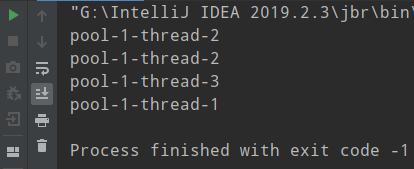1.线程池思想概述
- 频繁的消除和创建线程需要时间,对同一个线程反复的使用可以提高效率
2.线程池的概念
- 线程池:线程的集合
LinkedList<Thread> threads = new LinkedList<>();
添加线程:
LinkedList<Thread> threads = new LinkedList<>();
threads.add(new Thread("线程1"));
threads.add(new Thread("线程2"));
threads.add(new Thread("线程3"));
threads.add(new Thread("线程4"));
调用线程:
Thread thread01 = threads.removeFirst();
Thread thread02 = threads.removeFirst();
使用完毕,还回线程
threads.addLast(thread01);
threads.addLast(thread02);
JDK1.5之后:
- 使用线程池的工厂类
Executors里面的静态方法newFixedThreadPool()生产一个指定数量的线程池
ExecutorService es = Executors.newFixedThreadPool(3); 生产3个线程,
- 创建一个
Runnable接口的实现类,重写run()方法,设置线程任务
public class ImpRunnable implements Runnable{
@Override
public void run() {
System.out.println(Thread.currentThread().getName());
}
}
- 使用
ExecutorService中的方法submit(),传递线程任务(实现类),开启线程,执行run()方法
es.submit(new ImpRunnable());
import java.util.concurrent.Executor;
import java.util.concurrent.ExecutorService;
import java.util.concurrent.Executors;
public class Demo05 {
public static void main(String[] args) {
ExecutorService es= Executors.newFixedThreadPool(3);
es.submit(new ImpRunnable());
es.submit(new ImpRunnable());
es.submit(new ImpRunnable());
es.submit(new ImpRunnable());
}
}

- 使用
ExecutorService中的方法shutdown()销毁线程池(不建议使用)
es.shutdown();
